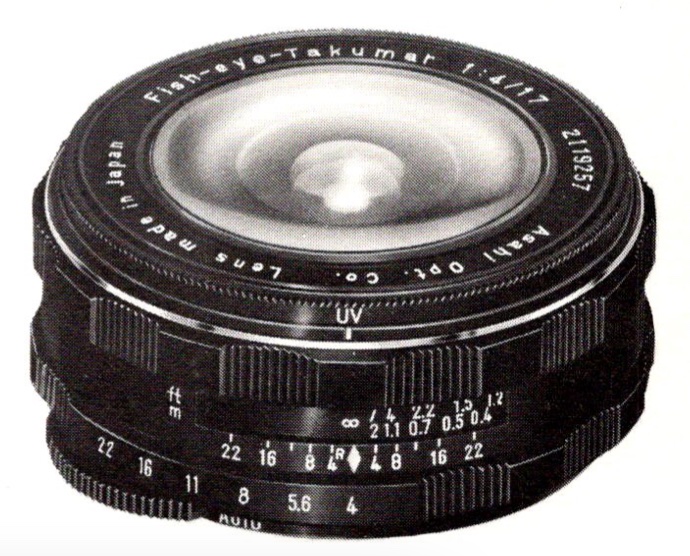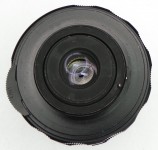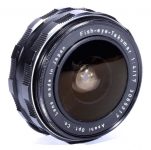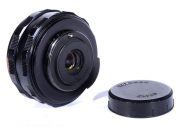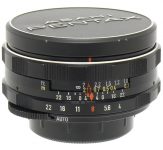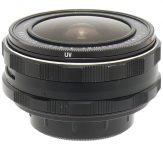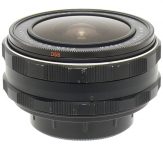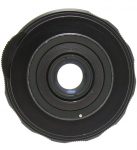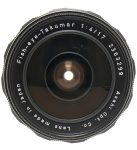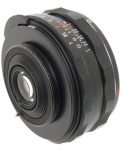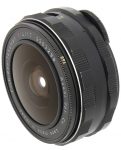Asahi Fisheye-Takumar 17mm F/4
Fisheye lens • Film era • Discontinued
- Announced:
- · 1967
- Production status:
- ● Discontinued
- Country of design:
- · Japan
- Original name:
- · Asahi Opt. Co. Fish-eye-Takumar 1:4/17
- Order No.:
- · 43841
- Class:
- · Slow full-frame diagonal fisheye lens
- System:
- · Asahi Pentax M42 (1957)
Abbreviations
| FISHEYE | An ultra-wide angle lens with strong uncorrected barrel distortion and extreme angle of view. |
Model history (3)
| ■Asahi Fisheye-Takumar 17mm F/4 [43841] | A | 11 - 7 | 0.20m | -- | 1967 ● | |
| ■Asahi Super-Multi-Coated Fisheye-Takumar 17mm F/4 [43842] | A | 11 - 7 | 0.20m | -- | 1973 ● | |
| ■smc Pentax 17mm F/4 Fisheye | A | 11 - 7 | 0.20m | -- | 1975 ● | |
Specification
| Optical design: | |
| 35mm full frame | |
| 17mm | |
| F/4 | |
| 11 elements in 7 groups | |
| Diagonal (full-frame) fisheye | |
| M42 [45.5mm] | |
| 180° | |
| Diaphragm mechanism: | |
Diaphragm type: | Automatic |
Aperture control: | Aperture ring (Manual settings only) |
| 6 (six) | |
| Focusing: | |
| 0.20m | |
| <No data> | |
Focusing modes: | Manual focus only |
Manual focus control: | Focusing ring |
| Physical characteristics: | |
| 228g | |
| ⌀66.5×31.5mm | |
| Accessories: | |
| Removable front filters are not accepted | |
| Built-in UV, O56, Y48 (part of the lens optical system) | |
| Not available | |
| Not available |
Sources of data
- The Ultimate Asahi Pentax Screw Mount Guide 1952-1977 book by Gerjan van Oosten (1999).
- Asahi Pentax Takumar interchangeable lenses operating manual (PUB. 06081).
- Asahi Pentax Takumar interchangeable lenses operating manual (red cover).
- Honeywell Photographic Products booklet (March 1969).
- Honeywell Pentax cameras, lenses, and accessories booklet (March 1971).
- Honeywell Photographic GSA Catalog and Price List (December 1, 1970 through November 30, 1971).
- Asahi Pentax ES operating manual (PUB. 06071).
- Asahi Pentax Spotmatic II operating manual (PUB. 06461, early).
- Honeywell Pentax SL operating manual (August 1969).
- Honeywell Pentax SP 500 operating manual.
- Honeywell Pentax Spotmatic II operating manual.
- Asahi Pentax Spotmatic II operating manual (PUB. 06461) (August 1972).
- Honeywell Pentax Spotmatic operating manual.
- Takumar lenses for the Asahi Pentax (PUB. 06091) (1971).
- Asahi Pentax Lenses & Accessories - Complete System of Photography (PUB. 06106).
Manufacturer description #1
The world's most efficient fish-eye lens with maximum brightness of f/4. Covers an angle of vision of about 180 degrees. Enables you to view and focus through the viewfinder without keeping the reflex mirror flipped up.
Manufacturer description #2
The 180° angle of the 17mm fish-eye lens gives you a new view of the world - you see things exactly as your lens sees them when you look through the viewfinder. And the maximum aperture of f4 makes this one of the world's brightest fish-eye lenses. It has the excellent resolution for which all Super-Takumar lenses are famous, and is equipped with a fully automatic diaphragm, and focuses through the viewfinder to as close as 20cm. Bring out the magic in photography with the Super-Takumar fish-eye.
Features
This unique Takumar fish-eye lens lets you view the image in the focusing screen without keeping the mirror up. Its angle of view is a full 180° diagonally across the frame, and the fully automatic diaphragm opens up to f4, giving a bright focusing image right down to 20cm. The specially designed 11 lens elements in 7 groups eliminate all aberration except for the degree of distortion and give edge-to-edge sharpness even with the diaphragm fully open.
Three fiIters are built into the lens - UV, Y2 (Y48), and 02 (O56) - as well as an adaptor for a gelatine filter at the back of the lens, making this a high-performance fish-eye lens that can hold its own in any company.
Main uses
The distortion and great depth of field make this a lens ideally suited for adding a fascinating new dimension to scenics, ordinary snapshots and commercial photography. Its fine color reproduction also recommends it to all color specialists.
Manufacturer description #3
An ultra wide-angle lens, and as such undoubtedly one of the most advanced of its kind in the world. More commonly known by photographers as 'Fish Eye' this designation is hardly surprising when considering the incredible 180° angle of acceptance (film diagonal). Asahi have achieved rare distinction in lens technology in that this lens may be fully employed in conjunction with the mirror and Pentaprism of the camera body, with normal through the lens viewing/composing, focusing, and in the case of Spotmatic, metering. For the record it may not be generally appreciated that with lenses of similar specification from other manufacturers this is quite impossible, as the rear projection of the back component prohibits the normal movement of the mirror mechanism, thereby forcing one to resort to the use of an ordinary optical accessory viewfinder. This has only been made possible due to the almost unbelievably compact and lightweight design which can be regarded as an optical breakthrough by the Asahi design group. Further the lens has not only fully automatic diaphragm, but also boasts the luxury of built-in filters, three in total, comprising UV, Y2, O2, selected by means of a rotating filter control ring.
Alternatively, an adapter is provided enabling the use of gelatine filters to be employed at the rear of the lens.
It is worth noting that even at full aperture standard of definition is remarkably good.
It is a lens primarily employed by those seeking imaginative and unusual photographic effects. Asahi have created this unique lens and opened up completely new fields of possibilities. Those seeking new means of photographic expression will themselves be the architects of unique and impressive achievement. Add to the general specification the fact that this lens will focus from infinity down to an incredible 20 cms. plus the brilliantly sharp image produced by the 7 groups of 11 individual elements and it is not difficult to see why it is in constant demand and use the world over.
Principal Uses
The almost unbelievable depth-of-field and fascinating degree of distortion both help make this lens the ideal objective where a new dimension is desired for the presentation of all scenic work and unique aspects of commercial and pictorial photography. The superb colour rendering should be of particular interest to all colour specialists.
Manufacturer description #4
This is an ultra-super-wide-angle lens, usually called a fish-eye lens, actually covering an ultra-wide-angle vision of about 180° on the film diagonal. Although the calculated angle of view is less, this ultra-wide-angle vision is possible due to the special effect of distortion. Unlike the extremely bulky fish-eye lenses for other single-lens reflex cameras, this Takumar fish-eye lenses is unbelievably compact and light-weight. Unlike the other fish-eye lenses, with which you can not use the camera's own pentaprism viewfinder (as you must keep the mirror flipped up), this fish-eye lens lets you see your subjects through the viewfinder of your Asahi Pentax, as the reflex mirror works without interruptions... another optical breakthrough by the Asahi Pentax designers.
This lens enables you to photograph "more than meets the eye." If you seek special photographic effects with your Asahi Pentax, add this to your line of the superb Takumar lens accessories. Utilizing the distortion unique with fish-eye lenses, this Takumar fish-eye lens opens a new vista in the single-lens reflex photography... it has now broken through the possibilities of the single-lens reflex photography.
It is equipped with a fully automatic diaphragm. Its maximum brightness of f/4 is just marvellous... it promises sharp focus even at full aperture. UV, Y2 and O2 filters are built-in and are changeable by rotating filter selector ring.
Asahi Super-TAKUMAR series
The third generation of lenses designed for Asahi Pentax 35mm SLR cameras with the M42 screw mount. Introduced with the Asahi Pentax SV and S1a in 1962.
- Robust, all-metal design with recessed focusing distance scale;
- Fully automatic diaphragm;
- Switch for automatic or manual diaphragm control;
- Extremely accurate manual focusing with knurled focusing ring;
- Improved single-layer anti-reflection coating.
Typical characteristics of fisheye lenses
- Extreme angle of view (at least 180° diagonally);
- Circular types (the image circle of the lens is inscribed in the image frame) or diagonal types (cover the entire image frame);
- Usually of equidistant projection type, with the distance from the picture center to any given point always proportional to the angle from the optical axis to that point;
- Huge barrel distortion;
- Short closest focusing distance (0.20 - 0.30m with 35mm full-frame prime lenses);
- Very large depth of field, eliminating the need for autofocus or precise manual focusing;
- Due to the extreme angle of view and convex front element, front filters cannot be used;
- Often equipped with a filter turret with swivel-mounted filters;
- Often come with a small, built-in petal-shaped lens hood.
From the editor
A very compact fisheye lens with diagonal angle of view of 180 degrees.
Despite the lack of the word “Super” in the lens’ name, it is in fact a Super-TAKUMAR lens with automatic diaphragm. In early Asahi / Honeywell booklets it was referred to as Fish-eye TAKUMAR 1:4/17, but later the Super-Takumar Fish-eye TAKUMAR 1:4/17 name was used.
The lens does not feature a filter thread. Instead, there are 3 built-in filters: UV, O56 and Y48. Please refer to the article dedicated to Super-Multi-Coated TAKUMAR 1:3.5/15 for information about these filters. There is also a gelatin filter holder at the back.
The front element of the lens is exposed to scratches or damage. Unfortunately, the lens hood is not available.
Honeywell Pentax SL, Honeywell Pentax Spotmatic II, Honeywell Pentax SP 500 and early edition of Asahi Pentax Spotmatic II operating manuals correctly state that the lens weighs 7.98oz but give incorrect weight in grams (288g instead of 228g).
Other fisheye lenses in the Asahi Pentax M42 system
| ■M42 mount (2) | |||||||||
| Asahi Super-Multi-Coated Fisheye-Takumar 17mm F/4 [43842] | A | 11 - 7 | 0.20m | -- | 1973 ● | ||||
| Asahi Fisheye-Takumar 18mm F/11 [356, 43560] • Pancake lens | M | 4 - 3 | 0.25m | -- | 1963 ● | ||||
Lenses with similar focal length
| ■M42 mount (7) | |||||||||
| Fuji Photo Film EBC Fujinon 16mm F/2.8 Fisheye | A | 12 - 8 | 0.25m | -- | ● | ||||
| Mamiya/Sekor SX Auto 14mm F/3.5 Fisheye | A | 10 - 7 | 0.30m | -- | ● | ||||
| Sigma MF 16mm F/2.8 Filtermatic Fisheye Multi-Coated | A | 9 - 8 | 0.15m | -- | 1980 ● | ||||
| Sigma[-XQ] MF 16mm F/2.8 Filtermatic Fisheye Multi-Coated | A | 11 - 9 | 0.15m | -- | 1978 ● | ||||
| Zodiak-2M-2 15mm F/3.5 Fisheye MC akaМС ЗОДИАК-2М-2 15mm F/3.5 | A | 9 - 5 | 0.20m | -- | 1979 ● | ||||
| Zenitar 16mm F/2.8 Fisheye MC akaЗЕНИТАР-К 16mm F/2.8 РЫБИЙ ГЛАЗ МС akaЗЕНИТАР-М 16mm F/2.8 РЫБИЙ ГЛАЗ МС akaЗЕНИТАР-Н 16mm F/2.8 РЫБИЙ ГЛАЗ МС | A | 11 - 7 | 0.30m | -- | 1990 ● | ||||
| Zenitar 16mm F/2.8 Fisheye MC | A | 11 - 7 | 0.30m | -- | ● | ||||
| ■Interchangeable mount (2) | |||||||||
| Sigma[-XQ] MF 16mm F/2.8 Filtermatic Fisheye Multi-Coated [YS] | A | 11 - 8 | 0.15m | -- | 1973 ● | ||||
| BelOMO Peleng A 17mm F/2.8 Fisheye MC [T] akaБелОМО ПЕЛЕНГ А 17mm F/2.8 МС РЫБИЙ ГЛАЗ | P | ? - ? | 0.30m | -- | ● | ||||
